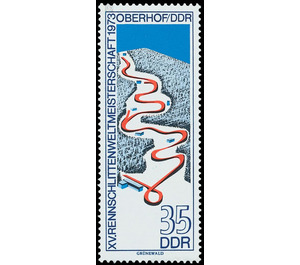XV. Race sledge world championship 1973 in Oberhof / DDR - Germany / German Democratic Republic 1973 - 35 Pfennig
Theme: Post & Philately
| Country | Germany / German Democratic Republic |
| Issue Date | 1973 |
| Face Value | 35.00 |
| Color | multi-colored |
| Perforation | K 12 1/2: 13 |
| Printing Type | offset |
| Stamp Type | Postage stamp |
| Item Type | Stamp |
| Chronological Issue Number | 1573 |
| Chronological Chapter | GER-DDR |
| SID | 516978 |
| In 29 Wishlists | |
XV. Race sledge world championship 1973 in Oberhof / GDR Zur XV. Race Carriage World Championship 1973 in Oberhof / GDR, the Ministry of Posts and Telecommunications of the German Democratic Republic issued a multi-colored special postage stamp. The race sledge track in Oberhof From the means of transport before the time sheet to the racing sled for sports purposes of today it is a long way. Much shorter was the time from the first prepared toboggan run in Davos / Switzerland in 1879 to the artificially icy race sledge track in Oberhof / GDR in 1971. According to international rules, a toboggan can only weigh 20 kg. About 70 to 90 km / h is the average speed with which the athlete passes the race track. Although sledding was already organized in many countries around the turn of the century, under the direction of the now-formed international organization - the Federation de Internationale de Luge de Course (FIL) - it was not until 1955 that the first World Cup took place in Oslo / Norway. The XV. World Cup 1973 was transferred due to the successes of East German athletes and the state of technical development in racing sled track construction of the German Democratic Republic. In compliance with international rules and trends, Oberhof has created a sports center of great sporting value and high safety for sportsmen and women of all ages and abilities. The racetrack consists of a self-supporting shell construction made of reinforced concrete with integrated pipe system for the artificial icing. 14 curves with radii from 12 to 28 m and different opening angles, a straight line and a target curve, which forms almost a circle, determine the athletic value of the system. The up to 5.5 m high curves are over-elevated to the crown and provided with a deflector. According to the latest findings, a dynamic calculation was made for the longitudinal and transverse profile of the railway. The 1,113.11-meter runway has four starting facilities, which are located approximately 400 meters from the finish line one after the other. With a maximum competition length of 1,032.89 m, the track has an average gradient of 9.2 percent with a height difference of 96.37 m. A road parallel to the route allows access to every point of the facility. Two observation towers, four take-off and one target building ensure the visibility of the entire runway without technical aids. The spout designed as a bridge structure ensures continuous deceleration of the sled and fits well into the technological process of the system. For the organization of evening and night events a glare-free halogen lighting - half fed by an emergency generator - installed. An electronic timepiece that displays up to 1 / 1,000 s, public address systems, a modern scoreboard, bleachers, sanitary facilities, catering outlets, etc. complete the currently most modern racing sled sports facility in the world. The location of the sports facility is located about 1,500 meters west of the village Oberhof, on a north-facing forest slope between the Tambacher and Zellaer Str, 831.5 m above sea level away.


